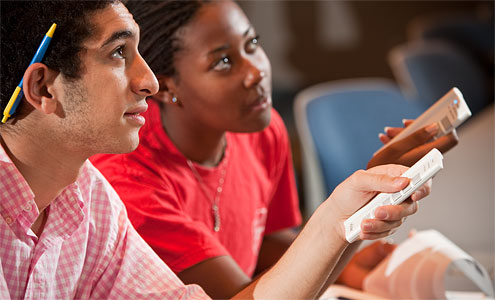
Complete the following sentence: Presenting a complex subject in a 50-minute lecture to a roomful of students: (A) creates a passive learning environment; (B) makes a real-time assessment of their comprehension difficult; (C) tempts students to miss class; or (D) can be an interactive experience that engages students, promotes attendance and provides immediate feedback to the instructor.
Some Wake Forest professors say D is the correct answer after using iClicker, an audience response system similar to the one used on the TV show “Who Wants to Be a Millionaire.”
Each student uses a wireless handheld device shaped like a remote control with five large buttons to respond to multiple-choice questions posed by the lecturer. A small box attached to the instructor’s computer receives the radio-frequency signals, records the “votes” and displays the results on the instructor’s computer.
Professor of Chemistry Robert Swofford is a proponent of classroom-response systems, after participating in successful pilot programs using PDAs in 2002 and smartphones in 2005. “Students who are just learning a challenging concept are reluctant to ask questions when they are not understanding,” Swofford notes.
For those students hesitant to raise their hands to ask a question in front of the whole class, the clickers offer a way to give anonymous feedback to the professor without feeling embarrassed. “Anonymity is liberating,” said Ian Gray, a junior biology major who is using iClicker for the first time in Physics 113, taught by Assistant Professor of Physics Jed Macosko.
That helps the professor, as well. “When not using iClickers, I only get feedback from a small number of students—those I ask or those who volunteer,” said Associate Professor of Physics Martin Guthold. “This small number of students may not be representative of the whole class.”
With iClickers, professors can see vote totals instantly displayed on a bar graph, revealing how many students voted and how many got the right answer, and then decide whether a concept needs further explanation.
“I often couldn’t hide my emotions when I saw the distribution of answers, and they were highly amused both when I was delighted or obviously disappointed,” said Reynolds Professor of Biology Susan Farhbach, who used iClickers last spring in a first-year biology class of 40 students. She saw better attendance on Friday afternoons and more attentive behavior among students when using iClickers.
Swofford said asking the right questions is vital to getting the right input. “A well-structured concept question often results in a ‘split vote,’ so students are given the opportunity to talk to their neighbors for a brief time to clear up the confusion,” he said. “That peer instruction has been shown to be an immensely valuable learning tool for the students.”
In addition to tracking understanding and participation, the polling feature can be used in a variety of creative ways. “I had a ‘physics challenge’ review session where we used iClickers in teams to have a fun competition in problem solving,” said Assistant Professor of Physics Timo Thonhauser. He even polled students on their favorite candidate for a new faculty position last year after they listened to lectures by each one.
Because many Wake Forest students are interested in medical careers and take courses in biology, chemistry and physics, all three departments adopted the same system. Each clicker costs about $30, adding a small amount to the hundreds of dollars students spend on textbooks every semester.
Overall, students seem enthusiastic about using clickers in class. Adam Lavis, a freshman in Robert Swofford’s chemistry class, said they help him pay closer attention during lectures. “It’s just a good, engaging tool,” he said.
Categories: Student
Headlines
Wake Forest in the News
Wake Forest regularly appears in media outlets around the world.




